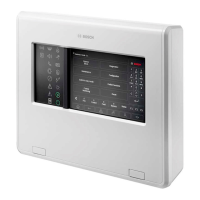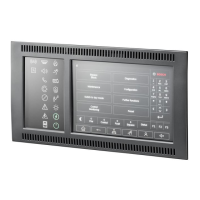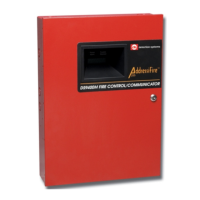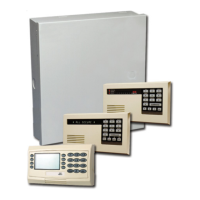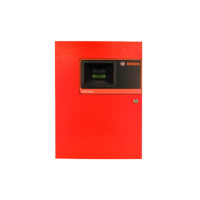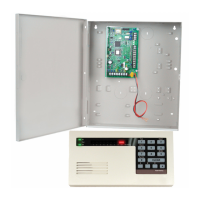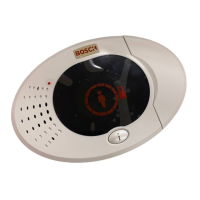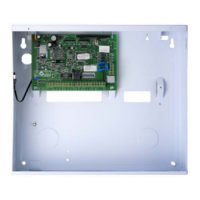Do you have a question about the Bosch AVENAR panel 8000 and is the answer not in the manual?
Instructions for operating the touch-sensitive display carefully.
Guidelines for cleaning and maintaining the touch screen and surfaces.
Information on using the fire panel according to EN54-2 standards and its capabilities.
Specifies personnel qualifications for processing event messages and system configuration.
Details innovations in AVENAR panel 8000/2000, including PNA/RSN, power button, and touchscreen calibration.
Information on the use of open-source software within the product and license details.
Instructions on how to return to the main start menu from any submenu.
Guide on how to change the panel's display language via shortcut or menu.
Describes the panel's fixed keys, including Home, Back, and navigation keys.
Explains the meaning of various status LEDs indicating the fire panel's operating status.
Provides instructions and cautions for operating the touch-sensitive display.
Describes the panel's standby screen and its displayed information when idle.
Details how to turn the fire panel on, off, and reboot it using the power button.
Guide for first-time panel setup, including touchscreen calibration, time/date, and network settings.
Instructions for logging in/out, managing passwords, and understanding access levels.
Navigating menus, lists, and returning to previous selections.
Overview of searching for elements using criteria like description or number.
How to configure IP settings for Ethernet connection, including default settings.
Covers network diagnostics, Ethernet redundancy, and remote services setup.
Describes the default programming and display behavior of the remote keypad.
Steps to establish a connection to a remote panel from the remote keypad.
Lists and describes various types of alarms such as Fire, Heat, Smoke, Water, and Supervisory.
Explains how to delay alarm signal transmission to prevent false alarms and allow message checking.
How alarm handling differs between day and night modes, including security levels and signal activation.
Describes how alarm messages are displayed, including optical/acoustic signals and zone status.
How to manually control all available evacuation zones, start/stop evacuation for zones.
Describes signals and basic actions like acknowledging, silencing, and resetting.
Process of verifying alarms, investigating times, and manually triggering alarms.
How to bypass detectors that have triggered an alarm to prevent further notifications.
How to display fault messages on the panel, including navigating the status bar.
Covers sequences, group/individual element info, signals, and resetting fault messages.
How to block an element that has caused a fault to prevent further notifications.
Provides an overview of the Bypass menu structure and its main functions.
Instructions for bypassing, un-bypassing, and listing bypassed elements and groups.
How to permanently bypass the panel's internal buzzer for maintenance.
Provides an overview of the Block menu structure and its functions.
Instructions for blocking and unblocking elements on the panel.
How to display a list of all blocked elements using the menu or status bar.
Provides an overview of the Diagnostics menu and its sub-sections.
How to display diagnostic information for elements within a selected LSN module.
How to display diagnostic information for modules, including passport, status, and LED tests.
Information on network services like routing tables, Ethernet ports, consistency checks, and ping commands.
Provides an overview of the Maintenance menu and its main functions.
Covers changing language and activating outputs/transmission devices.
How to bypass the panel's internal buzzer for maintenance purposes.
How to create, manage, add, and delete elements in walktest groups.
How to start, end, and review walktest results, including displaying tested elements.
How to select, set, change, and combine filters for the history log.
How to print the displayed list data, either the entire list or a specific range.
How to switch the panel between day and night modes via menu or status bar.
How to display lists of logical zones currently switched to day mode.
How to change the set back time for resetting to night mode.
How to set the physical node address (PNA/RSN) for the panel.
How to create, add, delete, and rename groups of elements.
How to change detector sensitivity settings between default and alternative options.
Covers operator passwords and renaming elements for better identification.
Covers network settings, date/time, remote services, and system configuration overview.
Provides an overview of the Further functions menu and its main sections.
How to change the panel's date and time settings.
Managing master passwords, remote services, operator passwords, and fire drills.
How to display and reset lifetime event counters for alarms and messages.
Provides an overview of the Reset menu and its functions.
How to reset elements to their initial state, including detectors and zones.
Provides an overview of the Control/Monitor menu and its sections.
How to control devices like HVAC and navigate to specific elements or functions.
Describes functions available in the boot menu, intended for trained experts only.
Instructions for operating the touch-sensitive display carefully.
Guidelines for cleaning and maintaining the touch screen and surfaces.
Information on using the fire panel according to EN54-2 standards and its capabilities.
Specifies personnel qualifications for processing event messages and system configuration.
Details innovations in AVENAR panel 8000/2000, including PNA/RSN, power button, and touchscreen calibration.
Information on the use of open-source software within the product and license details.
Instructions on how to return to the main start menu from any submenu.
Guide on how to change the panel's display language via shortcut or menu.
Describes the panel's fixed keys, including Home, Back, and navigation keys.
Explains the meaning of various status LEDs indicating the fire panel's operating status.
Provides instructions and cautions for operating the touch-sensitive display.
Describes the panel's standby screen and its displayed information when idle.
Details how to turn the fire panel on, off, and reboot it using the power button.
Guide for first-time panel setup, including touchscreen calibration, time/date, and network settings.
Instructions for logging in/out, managing passwords, and understanding access levels.
Navigating menus, lists, and returning to previous selections.
Overview of searching for elements using criteria like description or number.
How to configure IP settings for Ethernet connection, including default settings.
Covers network diagnostics, Ethernet redundancy, and remote services setup.
Describes the default programming and display behavior of the remote keypad.
Steps to establish a connection to a remote panel from the remote keypad.
Lists and describes various types of alarms such as Fire, Heat, Smoke, Water, and Supervisory.
Explains how to delay alarm signal transmission to prevent false alarms and allow message checking.
How alarm handling differs between day and night modes, including security levels and signal activation.
Describes how alarm messages are displayed, including optical/acoustic signals and zone status.
How to manually control all available evacuation zones, start/stop evacuation for zones.
Describes signals and basic actions like acknowledging, silencing, and resetting.
Process of verifying alarms, investigating times, and manually triggering alarms.
How to bypass detectors that have triggered an alarm to prevent further notifications.
How to display fault messages on the panel, including navigating the status bar.
Covers sequences, group/individual element info, signals, and resetting fault messages.
How to block an element that has caused a fault to prevent further notifications.
Provides an overview of the Bypass menu structure and its main functions.
Instructions for bypassing, un-bypassing, and listing bypassed elements and groups.
How to permanently bypass the panel's internal buzzer for maintenance.
Provides an overview of the Block menu structure and its functions.
Instructions for blocking and unblocking elements on the panel.
How to display a list of all blocked elements using the menu or status bar.
Provides an overview of the Diagnostics menu and its sub-sections.
How to display diagnostic information for elements within a selected LSN module.
How to display diagnostic information for modules, including passport, status, and LED tests.
Information on network services like routing tables, Ethernet ports, consistency checks, and ping commands.
Provides an overview of the Maintenance menu and its main functions.
Covers changing language and activating outputs/transmission devices.
How to bypass the panel's internal buzzer for maintenance purposes.
How to create, manage, add, and delete elements in walktest groups.
How to start, end, and review walktest results, including displaying tested elements.
How to select, set, change, and combine filters for the history log.
How to print the displayed list data, either the entire list or a specific range.
How to switch the panel between day and night modes via menu or status bar.
How to display lists of logical zones currently switched to day mode.
How to change the set back time for resetting to night mode.
How to set the physical node address (PNA/RSN) for the panel.
How to create, add, delete, and rename groups of elements.
How to change detector sensitivity settings between default and alternative options.
Covers operator passwords and renaming elements for better identification.
Covers network settings, date/time, remote services, and system configuration overview.
Provides an overview of the Further functions menu and its main sections.
How to change the panel's date and time settings.
Managing master passwords, remote services, operator passwords, and fire drills.
How to display and reset lifetime event counters for alarms and messages.
Provides an overview of the Reset menu and its functions.
How to reset elements to their initial state, including detectors and zones.
Provides an overview of the Control/Monitor menu and its sections.
How to control devices like HVAC and navigate to specific elements or functions.
Describes functions available in the boot menu, intended for trained experts only.
| Model | AVENAR panel 8000 |
|---|---|
| Redundant network | Yes |
| IP network | Yes |
| Resolution | 1280 x 800 pixels |
| Operating System | Linux-based |
| Protection Rating | IP30 |
| Type | Control Panel |
| Power Supply | 24 V DC |
| Communication Protocol | Ethernet, CAN |
| Number of control panel | Up to 32 in a network |
| Processor | ARM Cortex-A9 |
| Connectivity | Ethernet, USB, CAN |
| Display | 10.1-inch color touch screen |

